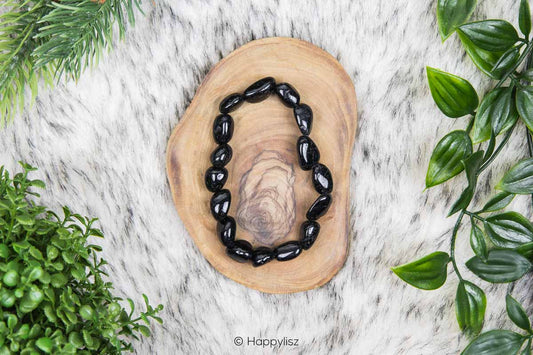Black Tourmaline

Grounding • Protective • Purifying • Against Negative Energy • Against Radiation • Against Worry
Appearance
A black, glossy crystal with a glassy to dull luster. In its raw form, it often has an elongated, prismatic shape with rough, irregular surfaces, and a needle-like appearance.
Rarity
Common.
Grounding • Protective • Purifying • Against Negative Energy • Against Radiation • Against Worry
Energetic properties
Black Tourmaline, or Schorl, is grounding, protective, and purifying. It is highly suitable for use as protection against all forms of negative energy and radiation. It also shields against black magic, voodoo, curses, and negative thoughts or anxiety. Physically, it supports the immune system, the back, muscles, and the nervous system, and it may help alleviate pain. It also offers protection against toxins and environmental pollution.
Suitable for children from around 8 years old.
Formation
Black Tourmaline typically forms in igneous rocks such as granite and pegmatites, which develop deep beneath the Earth's surface. It is the result of magma crystallization, where minerals like tourmaline form as the magma cools slowly under high pressure.
During the cooling and crystallization process, small cavities or fractures can form within the rock. Water containing dissolved minerals seeps into these spaces, and over time, the minerals begin to crystallize and grow. Black Tourmaline is one of the minerals that can form under these hydrothermal conditions.
Its black color is due to the presence of iron in the mineral’s chemical composition. Variations in the amount and distribution of iron can result in shades ranging from deep black to dark gray. Other trace elements may also influence its coloration. Tourmaline itself occurs in a wide range of colors, including green, yellow, blue, and pink, not just black.
Etymology
The name 'Tourmaline' is derived from the Sinhalese word 'turamali', meaning 'stone of mixed colors', referring to the many different colors tourmaline can appear in depending on its elemental composition. Tourmaline was first discovered in Sri Lanka.
The name 'Schorl' is commonly used to refer specifically to black tourmaline and comes from the medieval German term 'schürl' or 'schürlstein', meaning 'black stone'.
Care
Tourmaline is relatively hard and durable and doesn’t require special care. However, it is advisable to cleanse it regularly, as it can absorb a lot of negative energy. It can be cleaned under running water and gently patted dry with a soft cloth. It may also be cleansed and recharged using sage, incense or moonlight.
Origin
Can be found in regions including Afghanistan, Pakistan, Africa, Russia, Myanmar (Burma), Sri Lanka and the United States.
Availability
Black Tourmaline is relatively common and can be found worldwide, so it is generally not considered rare. However, tourmaline can vary in quality and size, and some rare forms; such as crystals with internal inclusions or exceptionally large specimens, can be valuable.
Properties
Composition: Na(Fe²⁺₃)Al₆(Si₆O₁₈)(BO₃)₃(OH)₃(OH)
Hardness: 7-8
Density: 3
Associated with Black Tourmaline






-

 Sold out
Sold outBlack Tourmaline - Crystal Bracelet
Regular price €15,00Regular priceUnit price / per -
Black Tourmaline - Raw Chunks
Regular price €4,00Regular priceUnit price / per -
Black Tourmaline - Tumbled Stone
Regular price From €5,50Regular priceUnit price / per -
Black Tourmaline in Mucovite - Raw Chunks
Regular price €12,50Regular priceUnit price / per -
Orgonite Disc - Seed of Life - Black Tourmaline
Regular price €15,00Regular priceUnit price / per€30,00Sale price €15,00Sale! -
Orgonite Disc - Sri Yantra - Black Tourmaline
Regular price €15,00Regular priceUnit price / per€30,00Sale price €15,00Sale! -
Orgonite Pendant - Shungite, Labradorite & Black Tourmaline - Cube of Metatron
Regular price €15,00Regular priceUnit price / per€30,00Sale price €15,00Sale! -
Orgonite Pyramid - Shungite, Labradorite & Black Tourmaline
Regular price €27,50Regular priceUnit price / per€55,00Sale price €27,50Sale!
















